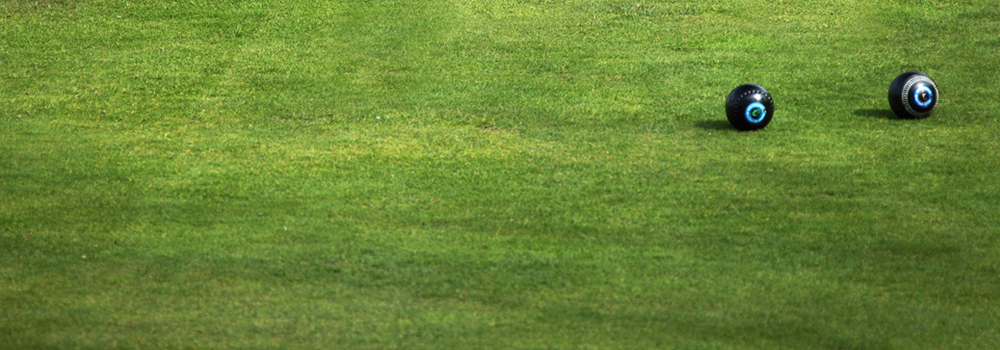
With the Bowls season coming to a close, you will be completing your final month of regular maintenance regimes, brushing, cutting and preparing the greens for matches. Grass growth will start to slow down once soil and air temperatures drop below double figures.
Key Tasks for September
General Maintenance
Before you arrange any work, it is best to examine the condition of your turf and soil profiles. Do not be afraid to take a couple of core samples from your green, allowing you the opportunity to see what lies below the surface. On examination, you should be able to see how much thatch you have and the condition of the soil.
Grass growth will start to slow down once soil and air temperatures drop below double figures. Your main concern for September will be organising your end of season renovation work; the extent and nature of the work will be entirely down to the condition of the green and what work you can afford to carry out.
Unfortunately, one of the deciding factors that often reduces the effectiveness of these planned works is the amount of money (budget ) the club has available. It can cost anything between £1200-£1500 for a contractor to come in and do all the work.
Savings can be made if the club undertake the work themselves, however, the effectiveness of the work carried out will be determined by the equipment they have at their disposal. Savings can also be made if clubs buy materials in bulk (several clubs group buying).
The best way to balance the health of the grass plant and to achieve good green speed is to promote and carry out effective cultural practices to maintain surface playability.
The following activities are generally implemented during autumn renovations and usually carried out in the following order, when conditions allow. The sequence of operations and their intensity will vary from green to green according to the condition at the end of the season.
Mowing the sward, preparing surfaces for renovation: lower cutting height to about 3-4mm to clean and prepare green for renovation operations. The mower can then be used to clean up the green after scarifying has been completed. With the season finished and the green closed down for the winter, mowing will only be required to maintain a winter height of cut at 8-12mm. Some clubs are now using rotary mowers to keep the greens tidy through the winter months. This methods does two jobs in one, it keeps the grass topped and hoovers up any surface debris, such as twigs and leaves.
Scarification, removal of unwanted debris: collect and disposal of arisings. Depending on the severity of the thatch, you may need to scarify several times in different directions. However, in most cases, if regular verticutting/grooming has taken place during the growing season, you would probably only be required to scarify in two directions. Do not scarify at right angles to the previous scarification line. Depth of scarification between 4-15mm, depending on depth of thatch to remove.
Aeration is the decompaction of soil, improving air and gas exchange in the soil profile. Depending on the turf's condition, you can choose to carry out hollow or solid tine spiking. Hollow tines are generally used on a bi-annual basis or when you have a severe thatch problem. Depth of aeration will be determined by the depth of your soil profile and what problems you want to rectify. Hollow tining is best achieved to a depth of between 75-100mm. Solid or slit tines can be set to penetrate deeper, ideally between 150-200mm.
Topdressing restores levels and improves surface drainage. Ensure you use compatible topdressing materials, sands, sand/soil mixes. Spreading can be achieved by several methods, utilising pedestrian or ride-on, disc or drop action top spreaders, or by hand using a shovel and a barrow. Best carried out in dry weather. It is important that the topdressings are spread uniformly. Brush to incorporate dressings and to help the grass stand back up. Brush in with a lute or drag brush/mat to restore levels.
Overseeding restores grass populations. It is important to ensure a good groove or hole is made to receive the seed; good seed to soil contact is essential for seed germination. Good moisture and soil temperatures will see the seed germinate between 7-14 days.
Fertilising, provides nutrients for grass growth. Apply a low N nitrogen fertiliser product, something like an NPK 5:5:15 to help the sward through the autumn period.
Irrigation is essential after renovations to ensure your seed germinates.
Renovations
Generally, you should be looking at a programme of scarifying in several directions to remove unwanted thatch layers and dead matter, aerating with some deep solid tines to break up compaction, topdressing with some 70-30 topdressing to restore levels, and overseeding with some new grass seed.
Unfortunately, one of the deciding factors that often reduces the effectiveness of these planned works is the amount of money (budget) the club has available. It can cost anything between £1200-£1500 for a contractor to come in and do all the work.
Savings can be made if the club undertake the work themselves, however, the effectiveness of the work carried out will be determined by the equipment they have at their disposal.
Savings can also be made if clubs buy materials in bulk (several clubs group buying).
The best way to balance the health of the grass plant and to achieve good green speed is to promote and carry out effective cultural practices.




As the end of the summer season approaches for fine turf, thoughts will be on renovations.
The key things here will be:
Aeration especially deeper forms of solid tine such as verti-draining. It also presents a good time of the year to undertake rotary decompaction with something like an Imants shockwave. Hollow tine aeration is also commonly undertake at this time of the year.
It is always wise to use nature to one’s advantage, and over seeding into September is the best time of the year to undertake this operation; it is the natural time of the year that the grass plant would naturally be dropping its seed with plenty of available warmth and moisture leading to good germination and successful establishment. Good soil contact and appropriate planting depth are also key to success with seeding although one should be careful to avoid rolling seed into the surface too aggressively, much better to allow natures rainfall to gently caress and firm the soil around the seed. Where machinery and equipment is available to the end user, disc seeding is a very reliable method of increasing germination rates, as the precise planting depth can be more accurately controlled into the slots which then close up nicely behind to provide firm soil contact.
Agronomically all turf managers should be on the lookout for disease pressure, the key times for infection being when warmth and moisture coincide, so periods of warm humid nights and damp days are periods everyone should pay attention to. Reducing the period of continual leaf blade wetness to below ten hours through gentle brushing and switching are a key method of cultural control. Chemically, it is warm enough to use a fungicide with a systemic action such as Heritage, Heritage Maxx or Interface as a preventative in the lead up to any operations, especially if environmental factors are conducive to disease.
September provides a really good opportunity for weed control, due to plenty of available moisture and warmth leading to good growth. The choice here is Bayer’s Longbow, with its 4 active ingredients and application rate of 7.5 l/ha it will give excellent control of a large variety of turf weeds. Users need to ensure it is applied a good three weeks before over-sowing, as newly germinated grass plants are sensitive to selective herbicides.
For anyone intending to use Merit Turf for the control of chafer grubs, then you have until 31st October 2016 to use or dispose of existing stocks following its withdrawal by CRD. Similarly for leather jackets, the use-up and disposal period for Cyren Chlopyrifos was 31st August 2015. This leaves us with biological control as the only approved option for the control of these turf pests. This is where we turn to native microscopic worms in the form of entomopathogenic nematodes. Nematodes are a proven control over many years but it is important to have an understanding and respecting the life cycles of the pest and control organism if you are to achieve the desired result. With this in mind, we have produced material to help educate both the professional and amateur alike. All the relevant information and advice can be found on the Nemasys product pages and this video sets out to explain the mind-set change you need to employ for success.
In terms of fertiliser regimes, then selecting a fertiliser with a lower nitrogen and higher potassium content is the way to go. Whether it is the establishment of new seed with the Lebanon ProScape 16-25-12 +25% MESA Pre-Seed Fertiliser or a quality autumn/winter feed such as Lebanon Country Club 8-4-24, the Lebanon range of controlled release fertilisers are a very cost effective choice on a cost per week calculation, which will give lasting and consistent results for clients for up to three months, something which is increasingly important with the onset of climate change and the consistently milder winters this seems to be regularly producing.
For anyone over seeding bent and fescue species then equipping them with the mycorrhizal fungi they need to thrive from the outset is a no brainer of a decision in this instance Maxwell Turf Food Myco 2 4-6-12 +4MgO providing the answer.
With the likelihood of some heavy, morning dews, a number of diseases may be prevalent at this time of the season.
Red thread, Fusarioum and Fairy rings can be a common sight on bowling greens at this time of the year. Click on the following links to view in depth articles about diseases:
Keep an eye on fungal disease attack and use approved fungicides to treat infected areas.
Regular brushing and sweeping are important tasks to keep the surface clean, open and dry. A dry surface will aid resistance to disease.
Please note: More information on these and many others can be found here: https://www.pitchcare.com/useful/diseases.php
Ensure you look after your equipment and store safe and secure, it is a good idea to get into a habit of washing down and cleaning after use.
- Keep your machinery clean and well serviced, check bottom blades and cylinders for sharpness.
- Keep machines overhauled and clean.
- Keep an eye on your material stocks (seed, topdressing, petrol, oil), remembering to replenish as required.

Delegates attending the Bowling Green course and using the accompanying manual will be able to develop their own skills, working knowledge and expertise, by understanding the method of instruction and the maintenance principle it sets out.
Included in the Course Manual, there are working diaries showing the range of tasks needed to be accomplished each month. The Course Manual is available for purchase separately.
In addition, we are able to arrange courses to be delivered on site to groups of 6 – 10 people. Email Chris Johnson for information.
- Brushing/switching of the playing surface keeps the green clean and removes any dew or surface water. Keeping the surface dry will aid resistance to disease.
- A simple test of thatch is the 'finger test'. If your thatch is one finger's width deep, you are okay; two fingers or more and you have a problem! The benefits of having about 6-8mm of thatch are it acts a sun screen, retains moisture, provides food for organisms to feed on and provides sources of humus.



